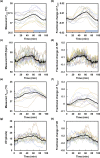Estimation of core body temperature by near-infrared imaging of vein diameter change in the dorsal hand
- PMID: 34513219
- PMCID: PMC8407806
- DOI: 10.1364/BOE.431534
Estimation of core body temperature by near-infrared imaging of vein diameter change in the dorsal hand
Abstract
Core body temperature (Tcore ) is a key indicator of personal thermal comfort and serves as a monitor of thermal strain. Multi-parametric sensors are not practical for estimating core temperature because they require long data collection times and a wide variety of settings. This study introduces dorsal hand vein dynamics as a novel indicator along with heart rate (HR) and dorsal hand skin temperature (Thand ) for predicting Tcore during rest following Tcore elevation. Twelve healthy males aged 27 ± 9 years old participated in the experiment. The experimental procedure consisted of a 10-min rest followed by 60 min of passive heat stress induced by leg immersion in hot water at 42°C and a 40-min thermal relaxation period after the legs were removed from the water. A near-infrared (NIR) imaging system was configured to monitor the dorsal hand veins during the entire experimental session. The values of HR, Thand , and Tcore were continuously monitored while the ambient temperature and relative humidity (RH) were maintained in a climate chamber at 20°C and 50%, respectively. Our selected predictor parameters demonstrated similar patterns in the Tcore such that the value increased as a result of passive heat stress and decreased in the thermal relaxation phase. The experimental data were divided into two phases: thermal stress and relaxation. At the resting condition, inclusion of the hand vein diameter (VD) improved the multiple linear regression value (R2 ) about 26%. At the relaxation phase, however, training regressions R2 = 0.68 and R2 = 0.94 were observed in the regression model with and without considering VD, respectively. The test regression value of R2 = 0.88 and the root mean square error (RMSE) of 0.18°C showed good agreement with the predicted values. These findings demonstrate acceptable validity of the non-invasive Tcore estimation at the resting condition. In particular, the inclusion of VD as a predictor in the regression analysis increases the prediction accuracy with a lower RMSE value.
© 2021 Optical Society of America under the terms of the OSA Open Access Publishing Agreement.
Conflict of interest statement
The authors declare no conflicts of interest.
Figures








References
-
- Yokota M., Berglund L. G., Santee W. R., Buller M. J., Karis A. J., Roberts W. S., Cuddy J. S., Ruby B. C., Hoyt R. W., “Applications of real-time thermoregulatory models to occupational heat stress: validation with military and civilian field studies,” J. Strength Cond. Res. 26, S37–S44 (2012).10.1519/JSC.0b013e31825ceba4 - DOI - PubMed
LinkOut - more resources
Full Text Sources
Miscellaneous
